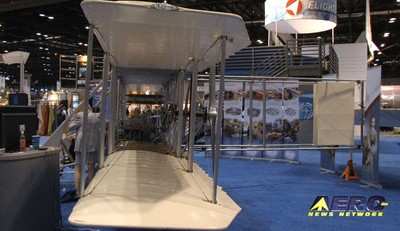Initial Investigation Finds No Obvious Cause For The Plane To
Go Down
While witnesses tell of an airplane that was struggling with its
engine varying in RPMs, the NTSBs initial examination of the Wright
B Flyer which went down on July 30th resulting in the fatal injury
of both pilots on board did not reveal anything overtly wrong with
the airplane. Of course, there is a lot to be looked into before a
probable cause can be established.
File Photo

14 CFR Part 91: General Aviation
Accident occurred Saturday, July 30, 2011 in Springfield, OH
Aircraft: WRIGHT B FLYER INC WRIGHT B FLYER, registration:
N453WB
Injuries: 2 Fatal.
This is preliminary information, subject to change, and may
contain errors. Any errors in this report will be corrected when
the final report has been completed.
On July 30, 2011, about 1055 eastern daylight time, N453WB, a
Wright B Flyer Inc. Wright B Flyer, experimental amateur-built
airplane, owned and operated by Wright B Flyer Inc., sustained
substantial damage on impact with terrain during a forced landing
near Springfield, Ohio. The pilot and the passenger, both
commercial pilots, sustained fatal injuries. The 14 Code of Federal
Regulations Part 91 flight test flight was not operating on a
flight plan. Visual meteorological conditions prevailed at the time
of the accident. The local flight originated from the
Springfield-Beckley Municipal Airport (SGH), near Springfield,
Ohio, approximately 1008.
According to statements given by witness in the area, the
airplane's engine sounded like its RPMs varied. The airplane was
observed to be flying slow and to bank to the left and right. One
witness reported that the airplane spiraled downward.
The airplane was located by first responders in a field about
one-half mile northwest of the intersection of South Pitchin Road
and North River Road. The airplane had a resting magnetic heading
about 210 degrees. The top wing was found displaced forward and
deformed downward over the forward portion of the lower wing and
engine. The lower forward empennage tubing was buckled and the
empennage was bent downward.

An on-scene examination of the wreckage was conducted. A liquid
consistent with the smell of aviation gasoline was found in the
bottom of the left fuel tank. The right fuel tank and the header
tank were compromised and no fuel was found in those tanks. The
fuel tank selector valve was selecting the right fuel tank. When
electric power was applied, the electric fuel pump emitted drops of
a liquid consistent with the smell of aviation gasoline. Flight
control cables and linkages were traced and all breaks were
consistent with overload. Engine control cables were traced and all
breaks were consistent with overload. The left magneto sustained
damage and was not able to be tested. The right magneto sustained
damage and it produced spark from its center electrode when it was
rotated. The top were removed. The spark plugs were gray in color
and no anomalies were detected. The engine driven fuel pump was
torn off its base.
A disassembly of the engine driven fuel pump revealed no
pre-impact anomalies. The fuel injection distribution valve was
disassembled and no anomalies were detected. The engine exhibited a
thumb compression at all cylinders. The fuel servo sustained damage
and its mixture control shaft had separated outboard of its mixture
control stop. The hose to the fuel servo screen contained drops of
a liquid consistent with the smell of aviation gasoline. The fuel
servo screen was free of debris. The oil filter canister was
removed and no debris was observed.
A hand held type Garmin Global Positioning System (GPS) was
recovered from the wreckage. The airplane had an engine monitor
installed. The airplane's engine monitor and the GPS were shipped
to the National Transportation Safety Board Recorder Laboratory for
readout.
 ANN's Daily Aero-Term (04.25.24): Airport Rotating Beacon
ANN's Daily Aero-Term (04.25.24): Airport Rotating Beacon ANN's Daily Aero-Linx (04.25.24)
ANN's Daily Aero-Linx (04.25.24) Klyde Morris (04.22.24)
Klyde Morris (04.22.24) Airborne 04.24.24: INTEGRAL E, Elixir USA, M700 RVSM
Airborne 04.24.24: INTEGRAL E, Elixir USA, M700 RVSM Airborne 04.22.24: Rotor X Worsens, Airport Fees 4 FNB?, USMC Drone Pilot
Airborne 04.22.24: Rotor X Worsens, Airport Fees 4 FNB?, USMC Drone Pilot




